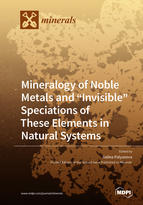Mineralogy of Noble Metals and “Invisible” Speciations of These Elements in Natural Systems
A special issue of Minerals (ISSN 2075-163X). This special issue belongs to the section "Mineral Deposits".
Deadline for manuscript submissions: closed (31 October 2019) | Viewed by 53510
Special Issue Editor
2. Department of Geology and Geophysics, Novosibirsk State University, 630090 Novosibirsk, Russia
Interests: ore-forming processes; experiment; thermodynamic modeling; minerals-indicators; fluid−mineral−rock interactions; gold mineralization; gold deposits; mechanisms of ore formation; reconstruction of T,P,X-conditions
Special Issues, Collections and Topics in MDPI journals
Special Issue Information
Dear Colleagues,
In nature, gold most commonly occurs as an alloy with silver and, more rarely, with platinum, palladium, and other elements, and ranges in size from nanoparticles to big nuggets. The origin of nuggets has been still debated. More and more novel mineral species, including the minerals of noble metals, are discovered every year. New phases containing Au, Ag, Pt, Pd, Rh, Ru are also known to be discovered, but the mineral has not been named yet. Still unsolved is the problem of the “invisible” speciations of gold, silver and other noble metals in sulfides and other minerals-concentrators of these elements. The chemistry and scales of the processes of dissolution, transport and deposition of noble metals have not been fully studied. Improved understanding of the genesis of deposits of noble metals in endogenic and supergene environments is necessary. The knowledge of the nature of gold occurrence and sites in gold-bearing minerals is significant for developing better process to extract gold from ores. The processes of consolidation, aggregation and purification of native elements under the conditions of formation of oxidation zones and placer deposits are poorly studied. It is known that gold content in the weathering crust considerably exceed that in endogenous sources. The mechanisms of this effect are still ambiguous and are attributed to different processes, including physicochemical and biological ones. Revealing of the role of the biogenic factor in the geochemistry of gold and other noble metals is an important task. Noble metals are a very popular in nanotechnology.
Dr. Galina Palyanova
Guest Editor
Manuscript Submission Information
Manuscripts should be submitted online at www.mdpi.com by registering and logging in to this website. Once you are registered, click here to go to the submission form. Manuscripts can be submitted until the deadline. All submissions that pass pre-check are peer-reviewed. Accepted papers will be published continuously in the journal (as soon as accepted) and will be listed together on the special issue website. Research articles, review articles as well as short communications are invited. For planned papers, a title and short abstract (about 100 words) can be sent to the Editorial Office for announcement on this website.
Submitted manuscripts should not have been published previously, nor be under consideration for publication elsewhere (except conference proceedings papers). All manuscripts are thoroughly refereed through a single-blind peer-review process. A guide for authors and other relevant information for submission of manuscripts is available on the Instructions for Authors page. Minerals is an international peer-reviewed open access monthly journal published by MDPI.
Please visit the Instructions for Authors page before submitting a manuscript. The Article Processing Charge (APC) for publication in this open access journal is 2400 CHF (Swiss Francs). Submitted papers should be well formatted and use good English. Authors may use MDPI's English editing service prior to publication or during author revisions.
Keywords
- Mineralogy of gold and other noble metals
- New minerals of noble metals
- The geochemistry of noble metals
- Chemistry and scales of processes of dissolution, transport and deposition of noble metals
- “Invisible” speciations of gold, silver, platinum, palladium in sulfides and other minerals
- Processes of consolidation, aggregation and mechanisms of formation of noble metal nuggets
- Differentiation of noble metals in ore forming processes
- Models for the formation of noble metals deposits
- Biogenic noble metals
- Noble metals and nanotechnology






